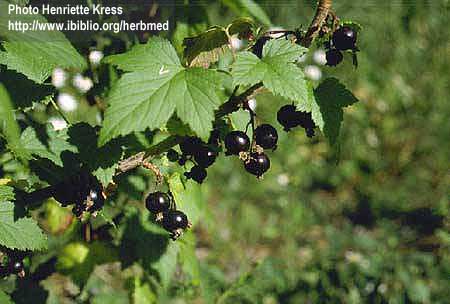Crops
Ribes nigrum L. - European black currant.
Taxonomy.
Family Grossulariaceae DC., genus Ribes L.There are 2 subspecies: R. nigrum subsp. europaeum Pavl. (European) и R. nigrum subsp. sibiricum (Egb. Wolf) Pavl. (Siberian).
Morphology and biology.
2n=16. Shrub 1.5-2 m. Shape of the shrub is sprawling or compact. Developed root system, main part of roots on the deep 30-40 cm. Shoots are streight, downy and pate in the beginning, then brown. Leaves with 3-5 sharp, wide-triangular blades; upper leaf surface naked, downy, dark-green; lower surface with pubescent nerves and specific yellowish glandules secreted aromatic substances. The flowers are small, campaniform, lilac-tinged or pinkish-grey, combined in 5-10-flowers racemes up to 8 cm length. Inflorescences on the shortened shoots. The mature berries are spherical, about 10 (up to 18) mm diameter, more often dark (black, dark-blue), but sometimes brown or green, with 3-37 seeds. Shrubs live up to 40-50 years, but after 20-25 years berries become small and harvest decreases. Separate brunches fructify during 5-7 years, beginning from 1-2 years of life.Distribution and origin.
Wild species grows in all Europe, in Siberia (till Baikal), on the north-east of Kazakstan. The currant as a garden plant beginning culture in Russia for the first time and already in 11 century reception in the monasteries gardens, in the ancient Russian towns and settlements (in West Europe in culture from end of 17 century). On the territory of the former USSR cultivated on several thousand hectares. Main plantations are in central regions of Russia, Ukraine, Volga regions.Ecology.
Low demand to heat. Winter-hardy. Optimal temperature for the growth +18-20°C; optimal temperature for photosynthesis +15-25°C (leaves fall down by temperature +39-42°C). Prefers damp fertile soils with subsoil waters not nearer than 1-1.5 m from surface. Least drought-resistant species among currant. Better growth on damp forest soil, chernozem, turf-podzol and inundated lands. Successful growth on the soils different mechanical composition - from light sandy soils to heavy-loam by sufficient bring of the fertilization. The currant black is cross-pollinated by different insects: beetles, flies, bees and other hymenopterouses. Self-pollination is possible.Economic value and agrotechnics.
R. nigrum is basic cultivated species of currant; cultivated in more than 25 countries of the world. There are more than 300 sorts in the former USSR. The best sorts from crossing of European and Siberian subspecies of R. nigrum. Poland, Russia and Germany are the largest producers of the currant black. There are great plantations in Moldova, Ukraine (more 9 thousands hectares), in Belarus (1.2 thousands hectares), in Russia (more than 62.6 thousands hectares; 1/2 on personal plots and collective gardens). In 1912 U. Hudjakov brought out the first Russian grade - Primorsky Chempion. The best sorts: Bagira, Belorusskaja sladkaja, Buraja dal.nevostochnaja, Vologda,Dikovinka, Moskovskaja, Minaj Shmyrev, Orlovija, Pamiatnik Michurina, Sejanets golubki, Chernyi zhemchug etc. The berries of the black currant contain 4.5-12.8% sugars, 2-4.5 % organic acids, up to 350 mg/100 g of damp mass of vitamin C, carotin, vitamins B1, B2, B6, B9, K1, E, PP1. Used in the fresh and dry kind, processed for jam, fruit jelly, compote, jelly, syrup, juice, and other drinks; the relish to dishes. It.s valuable officinal plant. The leaves are utilized for conservation of mushrooms and vegetables. Liqueur with buds used in food and alcohol industry. The average harvest is 5-10 ton berries per hectare.For sort qualities conservation the currant cloning: by grafts, arched, and by horizontal cuttings. The best period for planting is from 25 September to 10-15 October. Distance between shrubs is 1-1.5 m. Distance between lines of grafts is 50-70 cm, in the line - 12-15 cm. In dry autumn under-winter watering is necessary. Very valuable exemplars are propagated by division of shrubs. Mature, fruit bearing shrubs should have from 10-12 to 16-20 different age branches.
Literature.
Batalov V. V., Ignatev V. I. Berries cultures. Kucgesi, 2002. 144 p.Culture flora of USSR / E. V. Vulf (ed.). Vol. 16. Berries cultures. Moscow; Leningrad: Gosudarstvennoe izdatelstvo kolhoznoi i sovhoznoi literaturi, 1936. 285 p.
Efremova M. K., Lenskaja G. P. Catalogue (description of the sorts). Currant black, red, white, gooseberry. Moscow: Selskaja Nov, 1992. 71 p.
Novoselova T. G. Berry shrubs. Rostov-na-Donu: Feniks, 2003. 256 p.
Ravkin A. S. Black currant (initial material, selection, sorts). Moscow: MGU, 1987. 216 p.
Semionova L.G., Bzhetseva N.R. Peculiarities of black and red currants productivity in Adygeja conditions. Majkop: Ipris, 2003. 143 p.
Severin V. F. Black currant in Siberia (technology of the cultivation, procurement and re-making). Moscow: Rosagropromizdat, 1988. 93 p.
A high-grade division into districts of the fruit, berry cultures and hop-plant in RSFSR (catalogue). Moscow: ZNTIPR Gosagroprom RSFSR, 1988. 146 p.
Vehov V.N., Gubanov I.A., Lebedeva G.F. Cultural plants of the USSR. Moscow: Mysl.. 1978. 336 p.
Vitkovsky V. L. Fruit plants of the world. St-.Petersburg; Moscow; Krasnodar: Lan, 2003. 592 p.


